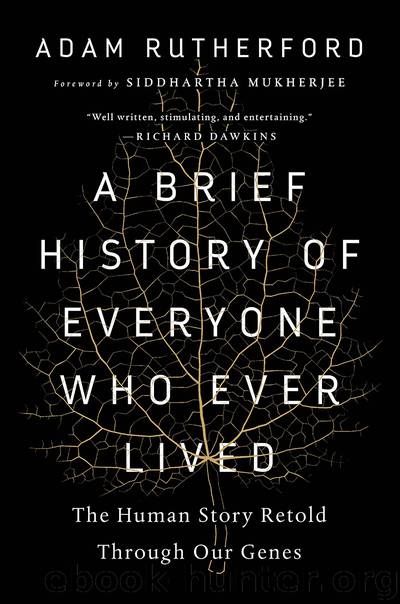A Brief History of Everyone Who Ever Lived by Adam Rutherford

Author:Adam Rutherford
Language: eng
Format: epub
Publisher: The Experiment
Published: 2017-04-19T04:00:00+00:00
Hush nae, hush nae, dinna fret ye,
The black Tinkler winna get ye.
According to Thomas Acton, a professor of Romani studies at the University of Greenwich, there isn’t a single verifiable case of Roma stealing non-Roma children in history.
In the modern age, it’s the clash of genetics and prejudice that fuels the myth. How could such a “blonde angel,” as Maria, the Greek girl, was rechristened by the press, not be a changeling, whisked away by swarthy Gypsies that were raising her? In fact, the two Irish children were returned to their homes following DNA tests that proved that they were being raised by their biological parents. Oddly, DNA revealed that the dark-skinned people raising Maria in Greece were not her birth parents, but after further enquiries her real Roma parents were found in Bulgaria. They had informally given Maria up for adoption to the Greek foster parents owing to their own poverty.
This blondness was not news to any geneticist. California-based genetics professor Leonid Kruglyak told me he was surprised anyone thought these kids couldn’t be blond. Nevertheless, the assumption that it was a genetic impossibility helped fuel suspicion because it tied neatly into a narrative, an ancient prejudice that Gypsies steal non-Roma babies. The Roma are a community of travelers whose genetics is somewhat peculiar. Estimates vary, but there are between 8 and 11 million Roma worldwide, most living in Europe. They emerged from India probably around the year 500 CE, according to a genetic analysis published in 2012, migrated through to the Balkans, and dispersed via Bulgaria around the eleventh century. There are Roma (also called Romani) enclaves in many European countries, and they show relatively high degrees of endogamy—mating within a social or cultural group—but also some breeding with local indigenous people. Nevertheless, the population as a whole appears to have had at least two bottlenecks, initially after leaving India, and then later as the Roma began to disperse into their different populations.
Estimates about levels of inbreeding are difficult to come by for the various Roma communities, but studies have tried to establish some of the underlying genetics of these people. More than nine different mutations that appear to be unique to Roma communities have been discovered, and a high level of carrier status for a few more. One of these is oculocutaneous albinism, a recessive condition that results in a lack of or highly reduced pigmentation in people with two mutated genes. There are different types, but people with OCA1B are not devoid of color as you think of typical albinos. Instead they have very light blond hair at birth, that darkens a touch over time, pale skin that slightly tans, and blue or green/hazel eyes. In Spanish Roma, the prevalence of carrier status for OCA1 is around 3.4 percent, possibly seven times higher than in the non-Roma population. With this high rate, at least in this Spanish population, which is a small and largely endogamous community, the presence of blond children in Roma families is virtually a genetic inevitability.
Download
This site does not store any files on its server. We only index and link to content provided by other sites. Please contact the content providers to delete copyright contents if any and email us, we'll remove relevant links or contents immediately.
Sapiens: A Brief History of Humankind by Yuval Noah Harari(13052)
Sapiens by Yuval Noah Harari(4537)
Homo Deus: A Brief History of Tomorrow by Yuval Noah Harari(4279)
Pale Blue Dot by Carl Sagan(4001)
Origin Story: A Big History of Everything by David Christian(3139)
Livewired by David Eagleman(3121)
Brief Answers to the Big Questions by Stephen Hawking(2878)
Inferior by Angela Saini(2831)
Origin Story by David Christian(2683)
The Evolution of Beauty by Richard O. Prum(2553)
Signature in the Cell: DNA and the Evidence for Intelligent Design by Stephen C. Meyer(2501)
The Gene: An Intimate History by Siddhartha Mukherjee(2491)
Aliens by Jim Al-Khalili(2382)
How The Mind Works by Steven Pinker(2213)
Sex at Dawn: The Prehistoric Origins of Modern Sexuality by Ryan Christopher(2150)
From Bacteria to Bach and Back by Daniel C. Dennett(2148)
A Short History of Nearly Everything by Bryson Bill(2135)
Endless Forms Most Beautiful by Sean B. Carroll(2083)
Who We Are and How We Got Here by David Reich(2059)
